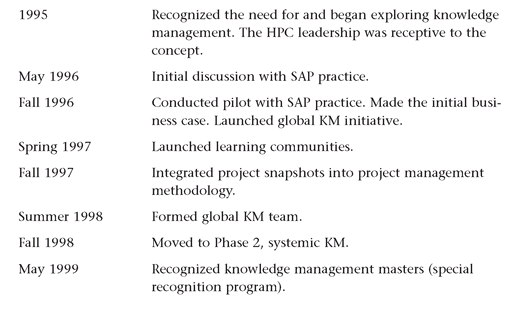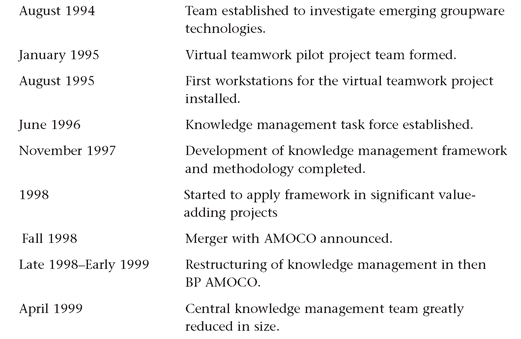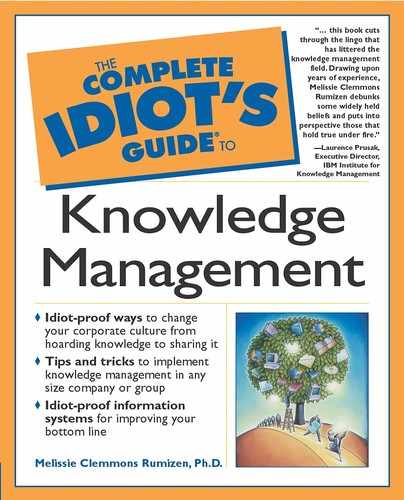
Chapter 24
Moving to the Big Time
In This Chapter
▶ Estimating time frames for implementing KM
▶ Learning from the pilot project
▶ Expanding the KM effort
▶ Embedding KM into the establishment
I remember all too well the end of a certain pilot for benchmarking I was involved in. Although there was some success, there also was more failure than I wanted to see. After we regrouped, our management decided the effort would continue, as it was part of a large initiative. I then moved to making benchmarking a permanent feature of the landscape. I figured it would be clear sailing from then on.
I was being naive again (well, I’ll admit to stupid this time). Within a few weeks, I couldn’t believe the change in my outlook. I couldn’t believe how many new problems appeared, and how much harder it was to scale up. It was my first lesson in how having a successful pilot doesn’t guarantee a successful program. A successful pilot doesn’t even guarantee that you’ll get a thumbs-up to proceed any further. You can bank on being much smarter than when you started. You’ll be ready to do a better job than you would have without a pilot. But you’re still under the gun. You can go from being the hero to being a goat. If anything, the pressure increases.

Know How
Exploring the concept and how others implement knowledge management is common and not at all unique to our two case studies. If you do nothing else as you explore, benchmark! Seeing that other people have done this successfully is believing. Plus you learn new ideas, methods, and pitfalls.
But this is the part that matters in the long run: embedding knowledge management into your organization. If you succeed, you’ll have changed the way work is done. Permanently. In this chapter, we’ll look at what’s involved in embedding knowledge management into an organization.
How Long Will It Take?
If you were in the same room with me, you’d probably be tugging on my arm and demanding to know how many years you should plan on to embed knowledge management. I’m tempted to say “more than the sentence for a misdemeanor, closer to some felonies, but less than first-degree murder,” but I’ll resist. In practice, the answer is that it depends. We’ll look at our two primary case studies, Hewlett-Packard Consulting and British Petroleum, to give you a rough idea.
Time Line at Hewlett-Packard Consulting
This abbreviated version of the time line later developed at Hewlett-Packard Consulting shows both the major activities and how long it took to implement their program.


Time Line for British Petroleum
This time line at BP, developed by Dr. Carol Gorelick, shows many similarities and also some differences.

Your time line could be entirely different. It’ll depend upon many factors:
▶ The size, geographic dispersion, uniformity (or the diversity), and other factors relating to your organization.
▶ The amount of resources, funds, and time you have. For example, BP had a central KM staff of about 10 full-time people plus one part-time. HPC had about 20 for an organization of around 6,000 people during the initial phases and today about 30-35.
▶ The complexity of your approaches.
▶ The fit of your approaches with the organizational culture.
Tread the fine line between being a hare or a tortoise as gracefully as you can. I predict this’ll necessitate much negotiation with your leadership and some adjustment as you go along.
Consolidating Lessons Learned
After the pilot it’s time to forward all of your phones, hang a sign on the door (Skiing in the North Pole—back in a few months), and lock yourself in. Even though you should have been reviewing as you went along, now is the time to reflect at length. You need to look back at the pilot from start to finish. It’s also time to switch from recommendations on the day-to-day work of the pilot to recommendations for scaling up—or quitting.

Know How
An acid test for your framework is how simply you can describe it. Take a receipt or another scrap of paper no larger than the back of a small envelope. Can you sketch your framework in that small space?

Know How
As part of an expansion you’ll need to bring new people on board. Even if you keep the original KM team, it’s hard to transfer all of what you’ve learned to new members. You may want to bring them in on your end-of-pilot review to help them come up to speed.
To do this, I suggest that you use the learning-after process called a retrospect developed at British Petroleum and documented by Chris Collison and Geoff Parcell in Learning to Fly. Essentially, a retrospect is a review of a project or other major effort. The goal is to examine the lessons learned and to make recommendations for the future.
Preparation before the meeting is critical. First of all, the meeting should be scheduled as soon as possible after the project ends. Make sure that you invite the right people. Find yourself someone to facilitate, someone who wasn’t involved in the pilot. The actual retrospect has several parts:
▶ Review of the project objectives and plans. Map out what happened, focusing on your tasks, deliverables, and decision points.
▶ Discussion of what worked well. Keep to the facts and insist on specific, repeatable advice.
▶ Discussion of what could have worked better. The purpose here isn’t to assign blame. The purpose is to avoid mistakes in the future. Focus on what people would do differently if they had it to do all over again.
▶ Decision on whether to recommend continuing or stopping. Now’s the time for brutal honesty. If you spent the pilot vainly begging for resources, arguing with leadership about the necessity for knowledge management, or losing to cultural issues no one’s willing to face, it may be time to hang up your hat. The world may have changed, too: decline in revenues, unexpected losses, or other sad events. Internal or external events beyond your control such as a sudden economic downturn may change the organizational climate to one that’s hostile.
Call it as you see it: continue or quit. If you continue, you’ll need to evaluate your vision and strategy. You’ll probably decide to recreate both. If you decide to stop there, at least try to make sure that the units using the approaches develop the supporting infrastructure they need to maintain them. Otherwise, if you just quit, you run the risk of losing all the ground you’ve gained. The organization will revert back to business as usual before you came along.
▶ Planning for the future. If you decide to recommend continuing, segue into planning. It’s time to put together an expansion strategy.
Expanding the Effort
Let’s now look at how you expand beyond the pilot. There’s a number of things you can do now.
Looking Again
Start with a clean slate on approaches. During the discussion of your expansion strategy, you may want to date around and marry some new approaches. If you had a single pilot with one approach, now’s the time to play the field before you settle down. HPC began with one pilot and then expanded its approaches.
The Rush for Gold
This phase can resemble a gold rush, as everyone heads out to stake a claim and start panning for gold. No doubt about it, you want lots of enthusiasm and eager participants. What you don’t want is folks going hog-wild and doing any darn fool thing they think of. Too much enthusiasm could lead to a big mess.

Know These
A retrospect is an in-depth review held at the end of a project or other significant piece of work. It usually lasts about a few hours. The purpose is to capture lessons learned and make recommendations for future projects.

Know Nos
Don’t allow anyone to sit silently in a corner. Make sure that everyone pipes up. A good way to start this rolling is to begin with a question that everyone has to answer, something simple like what was their role. Once people break the ice, they tend to keep contributing.
This is when you need some standards, policies, and procedures. You also need some enforcers (peaceful means only)—a central KM staff, an overseer group (such as the IT group at Hewlett-Packard Consulting), or some other group that can dance the dance of imposing as much order as is needed while still allowing people to exercise their creativity.
Ramping Up
You also have to decide how you will ramp up the effort. You have three options:
▶ Identifying specific projects and tailoring or developing approaches for them. Motorola does this well, always operating on a strict imperative to concentrate
 on projects that are linked to critical business objectives and also show a significant ROI. Projects often require fewer resources than an organization-wide approach and are easier to demonstrate concrete, specific results.
on projects that are linked to critical business objectives and also show a significant ROI. Projects often require fewer resources than an organization-wide approach and are easier to demonstrate concrete, specific results.

Know How
Valiantly try to time your recommendations so that any requests for resources match up with the proper time to submit budget requests. No matter how favorable your other circumstances may be, asking at the wrong time can put a hitch in your get-along.

Know How
You get what you pay for. If you decide against a global rollout, the amount of work and resources needed are less. The payoff for the organization is also less.
On the other hand, concentrating on specific projects can make it hard to embed knowledge management. For one thing, it creates an ongoing need for a central KM function, which can be more vulnerable to organizational shifts and stresses.
▶ Applying the approach(es) used in the pilot to other carefully selected areas of the organization. This middle strategy allows you to continue to target parts of your organization that are more receptive and, therefore, more likely to succeed. It also requires fewer resources than a global rollout.
This is another opportunity for brutal honesty. If you don’t think you can pull off a global rollout, by all means go for a more limited scale up.
▶ Moving to a global rollout.
Now you need a whole bunch of resources. One of those that could be a showstopper is a knowledge management staff that can facilitate the rollout. During expansion, central KM teams tend to increase in size geometrically. You also may want to position such people within actual business units, close to the work and preferably with an in-depth knowledge of how the work is done there.
The larger the rollout, the higher level of management support you need. I wouldn’t even dream of a global rollout without the CEO’s support. For one thing, it’s a matter of practicality. You just squared the resistance you will encounter.
Don’t regard the CEO merely as a bank to be wooed for funds. A former CEO once asked me and my colleague to do something that I wish we’d thought of ourselves: conduct an assessment similar to what Hewlett-Packard Consulting did when they questioned their customers. The experience was as harshly illuminating as a theatrical spotlight. By golly, the CEO’s some smart guy, I remember thinking. It changed the way I thought about him from being a semi-deity to just someone I worked with.
Paying for Your Sins
This is the time that mistakes you made way back when about scalability appear like the ghost of Christmas future to threaten you with a dismal end. Some could be:
▶ Poorly linking knowledge management to the business strategy
▶ Failing to consider cultural issues
▶ Picking supporting information technology that’s not scalable across the organization (and other IT mistakes)
▶ Skimping on training
▶ Neglecting to build a broad base of organizational support
▶ Doing a poor job of building your repertoire of communications skills and strategies
▶ Failing to show proof that knowledge management delivers value and is thus worthwhile
And so on. Actually, no matter how carefully you planned to scale up, my bet is that you’ll encounter some bumps along the road. Be prepared to deal with whatever problems pop up as you expand to the big time.

Know How
A supportive CEO can be one of your best partners. After all, this individual is in that position because of his or her abilities to formulate strategy, understand the business, and lead the culture. Regard your relationship as a collaboration. Of course, your culture may be more or less receptive to that concept and will help dictate how you handle it.

Know Nos
Never underestimate the disastrous effect of incompatible information technology, nor the determination of people to cling to their own systems. People sometimes claim their section is “special” and that without their particular information technology they can’t do their jobs. Appeals to the greater good can fail. You may be pushed to enlisting the heavy hand of senior leadership. But this is a battle worth fighting.
Let me tell you that it’s never too late to benchmark. Unless you compare yourself to external knowledge management programs, you have no way of knowing how good you are. Or how many gaps you have. You have no yardstick with which to measure yourself.
Sometimes you find out (to your immense surprise) that you’re the benchmark. It turns out that the people you thought were such hot stuff are bowled over by what you’re doing. Sometimes life is less kind, and you spend the exchange frantically taking notes and wondering if you’ll ever catch up.

Know Nos
Don’t indulge yourself in what benchmarkers call industrial tourism. That is a benchmarking visit with no clear objectives and no resulting action. Define what it is you wish to learn, choose benchmarking partners who have the knowledge you need, and tailor any exchange so that you can get actionable information.
Usually the results fall somewhere in the middle. Some of what you’re doing is great; some has room for improvement. But you’ll never know until you go outside your own walls.
At the same time, you know your own organization best. You can best test the organizational waters to see how you’re perceived internally. Don’t discount your own knowledge, but combine it with a realistic view of what others are doing.
As you get further along in the expansion, both looking outside and relying on your own knowledge can help you to assess the strengths of your program, the weaknesses, and options for making it better. But this will only happen if, like you did during the pilot and initial expansion, you take the time to evaluate what you’re doing.
Part of the Establishment
Until the top dog joins the team, you aren’t in the big time. You may have noticed (with envy) that both the top leader of Hewlett-Packard Consulting and British Petroleum were firmly committed to knowledge management. That’s typical. The American Productivity and Quality Center notes that the best practice organizations come to rely on the CEO having a personal belief in the efforts and including effective knowledge management as part of the organization’s vision.
However, depending upon your organizational scope you may be limited to embedding KM in a major business unit or division. In that case, you must have the support of the head of that unit or division, but not the CEO’s. Never forget that it’s extraordinarily difficult to embed KM across an entire large, global, and diversified organization in one fell swoop. Even with the CEO’s support!

Didn’t Know
In October 1996, the president of the World Bank, James D. Wolfensohn, announced the launching of an organization-wide strategy of knowledge sharing. He doesn’t seem to have lessened his commitment over the years, either. In the annual report of 2000, Wolfensohn’s message has a recurring thread of the importance of knowledge. He alludes to the important steps the World Bank has taken to advance the concept of a knowledge bank. He cites its experiences and lessons learned over the years. He writes of sharing knowledge with customers that is key to empowerment and progress.
Of course, even CEO’s can leave. Another way to embed knowledge management is to make it a permanent part of the way business is done. This may be spelled out in the strategic plan. It may be part of policy. Or it may simply be an explicit part of the way your organization does business. Then even if the CEO does leave, it’s more entrenched and harder to dislodge.
The time also has come to take on the reward and recognition system. If the current system fails to reinforce the behaviors needed for knowledge sharing, change it. I don’t underestimate how difficult this may be. But what gets rewarded gets done. Some organizations have created separate rewards and recognition for knowledge sharing.
You also could add new rewards and recognition to the existing system. That makes me a little uncomfortable, though. If other forms of rewards and recognition contradict knowledge sharing, I wonder which ones people will pay attention to.
Closely related and equally important is your performance evaluation system. A performance evaluation system should act as a coach, spelling out what behaviors are expected and giving suggestions, if needed, to steer someone back on track.

Know How
Performance evaluations feed promotions, another clear signal as to what’s really important at a company. A former colleague of mine even claims that promotion recommendations are the best indicator of what matters in any organization. There’s a lot to that.
You also need to decide what sort of supporting personnel structure you want for knowledge management:
▶ One option, particularly if that’s what you started with, is to maintain a centralized structure. You may want to move it, as the World Bank did by moving its
 KM staff from the CIO office to operations. Where it started life may not be the best place over the long run.
KM staff from the CIO office to operations. Where it started life may not be the best place over the long run.

Know Nos
Don’t ignore new-hire orientations as a vehicle for maintaining cultural values and beliefs. An influx of new people destabilizes an organizational culture. Even though you may not have a large influx, over time even a slow influx can have an effect. Although they’ll come in with their own cultural baggage, this is your chance to tell them what matters now in their new organization.

Know How
Although few companies are happy with the way they measure knowledge management, I do believe that as part of embedding it, you should consider measurement. I refer you back to Part 5, “Keeping Score.”
▶ Another is to reduce or eliminate the centralized support function and move roles to the local level. Hewlett-Packard Consulting did this and also increased the overall number of people in those roles. This puts the support folks closer to the actual work, as we discussed earlier.
▶ Another option is to eliminate the knowledge management function and outsource it. British Petroleum chose that option. In April 1999, it disbanded its central KM function.
With knowledge management, in addition to retaining several people on a KM staff, British Petroleum also decided to allow some members of the team to leave with the intellectual property and form an independent company. That company, Knowledge Transformation International, now contracts to provide knowledge management support for British Petroleum and other clients. The ties are so close that the majority of their people have BP e-mail accounts. You may think it was foolish to make that decision, but it is consistent with the BP way of doing business. It also ensures that they still get additional support as and when they require it.
Even if you dislike how BP handled it, it beats the heck of out declaring victory and sending all the troops home. That leaves no one to monitor how things are going and take action if necessary. Some believe that the hallmark of a truly successful knowledge management program is that a knowledge management staff disappears. I think that mind-set begs the question: If knowledge was so important that you launched an effort to better manage it, isn’t it worth a continuing effort and attention?
That mind-set also ignores organizational entropy, the tendency to regress to old habits. If no one remains to sound the clarion call to value knowledge, an organization might revert back to the bad old habits.
Whether or not a knowledge management function does the work, do establish a means for assessing and monitoring continuing knowledge management efforts.
The Least You Need to Know
▶ Developing, implementing, and embedding a knowledge management program usually takes years.
▶ After you complete your pilot, assess what you learned and decide whether or not to continue.
▶ If you decide to continue, map out an expansion strategy.
▶ To embed knowledge management in an organization, you must gain the support of the CEO, become part of the way business is done, and align rewards, recognition, and the performance evaluation system. You also must decide what sort of supporting knowledge management function you wish to have.
..................Content has been hidden....................
You can't read the all page of ebook, please click here login for view all page.
